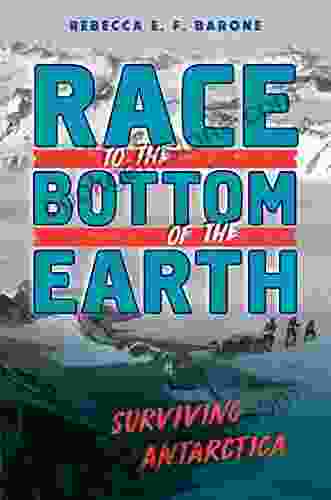Race to the Bottom of the Earth: A Journey to the Earth's Most Extreme Environment

The race to the bottom of the Earth is a tale of human endurance, scientific discovery, and international rivalry. In 1958, the United States Navy launched Operation Deep Freeze, a mission to establish a scientific research station at the South Pole. The Soviets followed suit, and soon the two superpowers were engaged in a race to reach the bottom of the Earth.
4.8 out of 5
| Language | : | English |
| File size | : | 63485 KB |
| Text-to-Speech | : | Enabled |
| Screen Reader | : | Supported |
| Enhanced typesetting | : | Enabled |
| Word Wise | : | Enabled |
| Print length | : | 261 pages |
The race was not without its dangers. The South Pole is one of the most extreme environments on Earth. Temperatures can drop to -100 degrees Fahrenheit, and the wind can reach speeds of over 100 miles per hour. The ice is treacherous, and there is always the danger of falling into a crevasse.
Despite the dangers, both the United States and the Soviet Union pressed on. In 1959, the United States established the South Pole Station, and in 1961, the Soviets established the Vostok Station. The two stations were located just 800 miles apart, and they became the focal point of the race to the bottom of the Earth.
The race was not just about reaching the South Pole. It was also about scientific discovery. The United States and the Soviet Union were both eager to learn more about the Antarctic continent, and they used their research stations to conduct a wide range of experiments. These experiments helped to shed light on the Earth's climate, geology, and biology.
The race to the bottom of the Earth also had a political dimension. The United States and the Soviet Union were locked in a Cold War, and the race to the South Pole was seen as a way to demonstrate their respective scientific and technological prowess. The race also helped to fuel the arms race, as both countries invested heavily in their military capabilities in order to support their Antarctic operations.
The race to the bottom of the Earth reached its climax in 1962, when the United States and the Soviet Union agreed to a treaty that banned all military activity in Antarctica. The treaty also established Antarctica as a scientific preserve, and it has helped to protect the continent from the ravages of war and exploitation.
The race to the bottom of the Earth is a story of human achievement and scientific discovery. It is a story of rivalry and cooperation, and it is a story that continues to inspire us today.
The South Pole
The South Pole is the southernmost point on Earth. It is located on the continent of Antarctica, and it is surrounded by the Southern Ocean. The South Pole is one of the most extreme environments on Earth. Temperatures can drop to -100 degrees Fahrenheit, and the wind can reach speeds of over 100 miles per hour. The ice is treacherous, and there is always the danger of falling into a crevasse.
The first person to reach the South Pole was Norwegian explorer Roald Amundsen. Amundsen and his team reached the pole on December 14, 1911, just one month ahead of a British expedition led by Robert Falcon Scott. Scott and his team died on their return journey from the pole.
The South Pole is now a popular destination for scientific research and tourism. The United States maintains a research station at the pole, and several other countries have established research stations nearby. The South Pole is also a popular destination for tourists, who come to see the ice, the penguins, and the other wonders of Antarctica.
The North Pole
The North Pole is the northernmost point on Earth. It is located in the Arctic Ocean, and it is surrounded by the Arctic ice pack. The North Pole is another extreme environment, with temperatures that can drop to -40 degrees Fahrenheit and winds that can reach speeds of over 50 miles per hour. The ice is also treacherous, and there is always the danger of falling into a crevasse.
The first person to reach the North Pole was American explorer Robert Peary. Peary and his team reached the pole on April 6, 1909, after a long and difficult journey. Peary's claim to have reached the pole has been disputed, but most historians believe that he did reach the pole.
The North Pole is now a popular destination for scientific research and tourism. The United States maintains a research station at the pole, and several other countries have established research stations nearby. The North Pole is also a popular destination for tourists, who come to see the ice, the polar bears, and the other wonders of the Arctic.
Antarctica
Antarctica is the coldest, driest, and highest continent on Earth. It is located in the Southern Hemisphere, and it is surrounded by the Southern Ocean. Antarctica is home to a variety of unique plants and animals, including penguins, seals, and whales. The continent is also home to a number of scientific research stations.
Antarctica was first discovered by Russian explorer Fabian Gottlieb von Bellingshausen in 1820. The continent was later explored by a number of other explorers, including James Cook, Ernest Shackleton, and Roald Amundsen. In 1959, the Antarctic Treaty was signed by 12 countries. The treaty banned all military activity in Antarctica and established the continent as a scientific preserve.
Antarctica is now a popular destination for scientific research and tourism. The continent is home to a number of research stations, and scientists from all over the world come to Antarctica to study the continent's unique environment.
The Arctic
The Arctic is the northernmost region of the Earth. It includes the Arctic Ocean and the surrounding landmasses. The Arctic is home to a variety of unique plants and animals, including polar bears, walruses, and seals. The region is also home to a number of indigenous peoples, including the Inuit, the Sami, and the Nenets.
The Arctic is a region of great environmental importance. The Arctic ice pack plays a key role in regulating the Earth's climate. The Arctic is also home to a number of important natural resources, including oil, gas, and minerals.
The Arctic is a region of increasing human activity. In recent years, there has been a growing interest in the Arctic's natural resources. This has led to a number of conflicts between countries that are interested in exploiting the Arctic's resources.
Exploration
The exploration of the Earth's poles is a tale of human curiosity, adventure, and scientific discovery. The first explorers to reach the poles were motivated by a desire to see what lay beyond the unknown. They faced incredible challenges, but they persevered and made some of the most important discoveries in human history.
The exploration of the poles continues today. Scientists from all over the world come to the poles to study the unique environment and to learn more about the Earth's climate and history. The poles are also a popular destination for tourists, who come to see the ice, the wildlife, and the other wonders of the polar regions.
Science
The exploration of the poles has led to a number of important scientific discoveries. Scientists have learned about the Earth's climate, geology, and biology by studying the poles. The poles have also been used to study the effects of human activity on the environment.
The poles are a vital part of the Earth's ecosystem. The ice at the poles helps to regulate the Earth's climate. The poles are also home to a variety of unique plants and animals. The poles are a reminder of the importance of protecting the environment.
Discovery
The exploration of the poles has led to a number of important discoveries. These discoveries have helped us to learn more about the Earth and its place in the universe. The poles are a reminder of the human spirit of exploration and discovery.
The race to the bottom of the Earth is a story of human achievement, scientific discovery, and political rivalry. It is a story that continues to inspire us today.
Adventure
The exploration of the poles is a story of adventure. The explorers who first reached the poles faced incredible challenges. They had to battle extreme weather conditions, treacherous ice, and dangerous wildlife. But they persevered and made some of the most important discoveries in human
4.8 out of 5
| Language | : | English |
| File size | : | 63485 KB |
| Text-to-Speech | : | Enabled |
| Screen Reader | : | Supported |
| Enhanced typesetting | : | Enabled |
| Word Wise | : | Enabled |
| Print length | : | 261 pages |
Do you want to contribute by writing guest posts on this blog?
Please contact us and send us a resume of previous articles that you have written.
 Best Book
Best Book Page Flip
Page Flip Bookshelf
Bookshelf Literary loom
Literary loom Chapter
Chapter Bookish
Bookish PageTurner
PageTurner Bibliophile
Bibliophile Story
Story Inkwell
Inkwell Bookworm
Bookworm Labyrinth
Labyrinth Plot Twist
Plot Twist Prose
Prose Paperback
Paperback Storyteller
Storyteller Sanctuary
Sanctuary Fiction
Fiction Reading
Reading Chronicle
Chronicle Read
Read Peter Mansfield
Peter Mansfield John Henderson
John Henderson Francis J Buckley
Francis J Buckley Jocelyn Jane Cox
Jocelyn Jane Cox Seth Abramson
Seth Abramson Luca Brambilla
Luca Brambilla John Germov
John Germov Mark Dawson
Mark Dawson Kevin Shea
Kevin Shea Robert Crais
Robert Crais Boye Lafayette De Mente
Boye Lafayette De Mente Pamela K Lamb
Pamela K Lamb General
General Savage Greenboro
Savage Greenboro Prasad Raju V V N R Pathapati
Prasad Raju V V N R Pathapati Mike Kraus
Mike Kraus Frosty Wooldridge
Frosty Wooldridge Wayne J Lutz
Wayne J Lutz John Howells
John Howells Dan Fullerton
Dan Fullerton Helen Dunn Frame
Helen Dunn Frame Educational Testing Service
Educational Testing Service L Waxy Gregoire
L Waxy Gregoire Ross Blankenship
Ross Blankenship Michel Roy
Michel Roy Matthew Simon
Matthew Simon Joseph Phillips
Joseph Phillips Paul Murton
Paul Murton Gerald Hausman
Gerald Hausman Georgios Papadakis
Georgios Papadakis Keri Bloomfield
Keri Bloomfield Richard Bak
Richard Bak Mike Chambers
Mike Chambers Michele G Kunz
Michele G Kunz Hannah Tyson
Hannah Tyson Illustrated Edition Kindle Edition
Illustrated Edition Kindle Edition Kenneth Oppel
Kenneth Oppel Shanta Kumar
Shanta Kumar Markes E Johnson
Markes E Johnson Emily Kimelman
Emily Kimelman Jearl Walker
Jearl Walker Laura Peyton Roberts
Laura Peyton Roberts Carlos A Caggiani
Carlos A Caggiani Alex Hibbert
Alex Hibbert Elizabeth Hay
Elizabeth Hay Manfred Theisen
Manfred Theisen Warwick Trucker
Warwick Trucker Christine Wilcox
Christine Wilcox Richard Henry Dana
Richard Henry Dana Khaled Hosseini
Khaled Hosseini Ben Tall
Ben Tall Nielson Phu
Nielson Phu Supersummary
Supersummary Gavin Francis
Gavin Francis Maria Montessori
Maria Montessori Dr John Hockey
Dr John Hockey Mitt Romney
Mitt Romney Jeff Hay
Jeff Hay Bob Shepton
Bob Shepton Redhen Family
Redhen Family Chic Scott
Chic Scott Jesse M Ehrenfeld
Jesse M Ehrenfeld Kanchan Suyash
Kanchan Suyash Peterson S
Peterson S Cindi Myers
Cindi Myers Ged Wilmot
Ged Wilmot Tim Dowley
Tim Dowley Dr Ray Makar
Dr Ray Makar Caitlin Doughty
Caitlin Doughty J R Klein
J R Klein Xavier Marie Bonnot
Xavier Marie Bonnot Moshe Ohayon
Moshe Ohayon Lance Pototschnik
Lance Pototschnik Jen Beck Seymour
Jen Beck Seymour Kevin Biggar
Kevin Biggar Carla Mooney
Carla Mooney Ashley Schmitt
Ashley Schmitt Kathleen Norris
Kathleen Norris Huma Filo
Huma Filo Sport Hour
Sport Hour A R Vasishtha
A R Vasishtha Prepvantage
Prepvantage Edulink Gmbh
Edulink Gmbh John Rae
John Rae Gil Martin
Gil Martin Tiara R Brown
Tiara R Brown Horace C A
Horace C A Sandra Dallas
Sandra Dallas Lucy Coleman
Lucy Coleman Ken Chaddock
Ken Chaddock Julia Ann Clayton
Julia Ann Clayton Grady Hendrix
Grady Hendrix Laura Lincoln Maitland
Laura Lincoln Maitland John Morrison
John Morrison Rob Pate
Rob Pate Katherine Nouri Hughes
Katherine Nouri Hughes April Vahle Hamel
April Vahle Hamel Kerry Karram
Kerry Karram Paul Ames
Paul Ames Jack Slater
Jack Slater Ted Kulfan
Ted Kulfan Roy Fisher
Roy Fisher Dr Hooelz
Dr Hooelz Morgan Stafford
Morgan Stafford John Seibert Farnsworth
John Seibert Farnsworth Skip Hollandsworth
Skip Hollandsworth Janet Chapple
Janet Chapple Fridtjof Nansen
Fridtjof Nansen Michael Vlessides
Michael Vlessides Ian C Friedman
Ian C Friedman Vincent Chidindu Asogwa
Vincent Chidindu Asogwa Smart Edition
Smart Edition Nadav Snir
Nadav Snir Wickaninnish Inn
Wickaninnish Inn Laura Ben David
Laura Ben David Marie Benedict
Marie Benedict Nigel Cliff
Nigel Cliff Konstantinos Mylonas
Konstantinos Mylonas Joel J Lerner
Joel J Lerner Erin Trahan
Erin Trahan Baby Professor
Baby Professor Bookrags Com
Bookrags Com Businessnews Publishing
Businessnews Publishing Michael Renshaw
Michael Renshaw Lingo Mastery
Lingo Mastery John W Lundin
John W Lundin Steve Warner
Steve Warner Janice K Ledford
Janice K Ledford Genius Reads
Genius Reads Martin Woodward
Martin Woodward Pip Williams
Pip Williams David Archer
David Archer Lawrence Durrell
Lawrence Durrell Seyyed Hossein Nasr
Seyyed Hossein Nasr Edwyn Forest
Edwyn Forest Randy Wayne White
Randy Wayne White Nachole Johnson
Nachole Johnson Kaye Edwards
Kaye Edwards Wayne Johnston
Wayne Johnston Marie Cirano
Marie Cirano Michael Corayer
Michael Corayer Felicie Williams
Felicie Williams Proprietary Edition Kindle Edition
Proprietary Edition Kindle Edition Trivium Test Prep
Trivium Test Prep Rich Polanco
Rich Polanco Steve Schwartz
Steve Schwartz Nicholas J Cotsonika
Nicholas J Cotsonika Saroo Brierley
Saroo Brierley Ilona Andrews
Ilona Andrews Mark Lee
Mark Lee Rico Austin
Rico Austin Richard Kadrey
Richard Kadrey Nick Angelis
Nick Angelis Nicolas Rodak
Nicolas Rodak Magnus D Jango
Magnus D Jango Ben Malisow
Ben Malisow Raquel Baccetto
Raquel Baccetto Eric Engle
Eric Engle Hugh Sinclair
Hugh Sinclair Tim Bauerschmidt
Tim Bauerschmidt Sylvain Tesson
Sylvain Tesson Lesley Jane Eales Reynolds
Lesley Jane Eales Reynolds Bruce Boudreau
Bruce Boudreau Margaret K Nydell
Margaret K Nydell Cyndi Kinney
Cyndi Kinney Fatime Losonci
Fatime Losonci Bright Summaries
Bright Summaries Miles Martin
Miles Martin Jeffrey Alford
Jeffrey Alford Noor De Olinad
Noor De Olinad Anuj Tikku
Anuj Tikku Rick Steves
Rick Steves Cliff Seruntine
Cliff Seruntine C E Flores
C E Flores Viki Winterton
Viki Winterton Nick Adams
Nick Adams Mary Ann Hogan
Mary Ann Hogan Kazim Ali
Kazim Ali Ibl Press
Ibl Press Kristopher Martel
Kristopher Martel 50minutes Com
50minutes Com Smart Reads
Smart Reads One Edition Kindle Edition
One Edition Kindle Edition Patrick O Sullivan
Patrick O Sullivan John Hemming
John Hemming Nisha Garg
Nisha Garg John Hiker
John Hiker Jenny Mackay
Jenny Mackay Helene St James
Helene St James Eric Newman
Eric Newman Janet Evans
Janet Evans Julia Quinn
Julia Quinn Sigurd F Olson
Sigurd F Olson J D Ware
J D Ware W M Raebeck
W M Raebeck Rajani Katta
Rajani Katta Sophie Fuggle
Sophie Fuggle Wizer
Wizer Stephen Haddelsey
Stephen Haddelsey Bruce Hunt
Bruce Hunt Rupika Raj
Rupika Raj Matt Racine
Matt Racine Pauline Harmange
Pauline Harmange Ross Bonander
Ross Bonander Nikki Nichols
Nikki Nichols Dr Jyuthica Laghate
Dr Jyuthica Laghate Doug Gaskill
Doug Gaskill Robert Finch
Robert Finch Helen Wenley
Helen Wenley Benjamin P Bowser
Benjamin P Bowser Paul Watson
Paul Watson Robert N Rosen
Robert N Rosen Rhonda Leeman Taylor
Rhonda Leeman Taylor Jared Derksen
Jared Derksen Juliet Grames
Juliet Grames Hugo Banzer Suarez
Hugo Banzer Suarez Terry Frei
Terry Frei Monica Sorrenson
Monica Sorrenson Vince Kotchian
Vince Kotchian Andrew Hempstead
Andrew Hempstead Brian Mcfarlane
Brian Mcfarlane Rochelle Knight
Rochelle Knight Dixie Dansercoer
Dixie Dansercoer Luisa Gastambide
Luisa Gastambide Jean Vives
Jean Vives Kaplan Test Prep
Kaplan Test Prep Khalid Khashoggi
Khalid Khashoggi Lynda Field
Lynda Field Michelle Larkin
Michelle Larkin Rachel Russ
Rachel Russ Tony Horwitz
Tony Horwitz Scott Butler
Scott Butler Tessa Dare
Tessa Dare Bob Duff
Bob Duff W E B Griffin
W E B Griffin Trevanian
Trevanian Louis L Amour
Louis L Amour Sigrid Fry Revere
Sigrid Fry Revere Robert Collins
Robert Collins Patricia Briggs
Patricia Briggs Andy Kirkpatrick
Andy Kirkpatrick Brooks Fiesinger
Brooks Fiesinger Ray Walker
Ray Walker Jamie Jensen
Jamie Jensen Jackson Carter
Jackson Carter Tao Le
Tao Le Ken Griffey Jr
Ken Griffey Jr Russell Streeter
Russell Streeter Tim Notier
Tim Notier Steven W Dulan
Steven W Dulan Kate Williams
Kate Williams Brandon Royal
Brandon Royal Caryn Boddie
Caryn Boddie Snap Summaries
Snap Summaries United States Government Us Army
United States Government Us Army Alexis Lipsitz Flippin
Alexis Lipsitz Flippin Lonely Planet
Lonely Planet Insight Guides
Insight Guides Jeanie Buss
Jeanie Buss Stuart Woods
Stuart Woods Paul Johnson
Paul Johnson Stan Skrabut
Stan Skrabut Jonny Zucker
Jonny Zucker George Orwell
George Orwell R Raman
R Raman Harley Wylde
Harley Wylde Nicholas Bjorn
Nicholas Bjorn Christophe P Yerling Ph D
Christophe P Yerling Ph D Ron Siliko
Ron Siliko Laura Lee Smith
Laura Lee Smith Luca Vargiu
Luca Vargiu Andrew Hudgins
Andrew Hudgins Narasimha Karumanchi
Narasimha Karumanchi Emily Colin
Emily Colin Susan Weese
Susan Weese Anita Landoll
Anita Landoll Joeanna Rebello Fernandes
Joeanna Rebello Fernandes Fiona Gibson
Fiona Gibson Julia Alvarez
Julia Alvarez Douglas Preston
Douglas Preston Neha Gupta
Neha Gupta Sterling Test Prep
Sterling Test Prep Garry Burnett
Garry Burnett Tim Hannigan
Tim Hannigan Stephen John
Stephen John Robert B Parker
Robert B Parker Philip Jackson
Philip Jackson Len Airey
Len Airey Alan Charlesworth
Alan Charlesworth Lewis Morris
Lewis Morris Michelle Lee
Michelle Lee Rebecca E F Barone
Rebecca E F Barone Stephen Ausherman
Stephen Ausherman Colson Whitehead
Colson Whitehead Simon Turney
Simon Turney William Shakespeare
William Shakespeare Kristin Hannah
Kristin Hannah J Maarten Troost
J Maarten Troost Zigzag English
Zigzag English Mark Greaney
Mark Greaney L T Ryan
L T Ryan Um A Yube
Um A Yube Zanna Sloniowska
Zanna Sloniowska Rod Kulbach
Rod Kulbach Ian Tuhovsky
Ian Tuhovsky Philip Donlay
Philip Donlay Lawrence Osborne
Lawrence Osborne Karsten Heuer
Karsten Heuer Lally Brown
Lally Brown Jason Hogan
Jason Hogan Eric Bodnar
Eric Bodnar Balazs Csigi
Balazs Csigi Joseph Toone
Joseph Toone Quick Reads
Quick Reads Narendra Kumar V
Narendra Kumar V Jon A Archambault
Jon A Archambault Mark Zegarelli
Mark Zegarelli Aminta Arrington
Aminta Arrington Approach Guides
Approach Guides Michele Shriver
Michele Shriver Print Replica Kindle Edition
Print Replica Kindle Edition William Ma
William Ma Robert Cargill
Robert Cargill Evie Litton
Evie Litton Cosmic Kids Publications
Cosmic Kids Publications Tony Mendoza
Tony Mendoza Justin Goldman
Justin Goldman Nicholas Gallo
Nicholas Gallo Gregg Hurwitz
Gregg Hurwitz William Pitts
William Pitts Meghan Mccarthy
Meghan Mccarthy Anna Curran
Anna Curran Fethi Mansouri
Fethi Mansouri Jim Mancuso
Jim Mancuso Fodor S Travel Guides
Fodor S Travel Guides Kayla Chalko
Kayla Chalko John Merriam
John Merriam Jane Moore
Jane Moore Jay H Lefkowitch
Jay H Lefkowitch Kevin Marx
Kevin Marx David Gordon
David Gordon James Cowan
James Cowan Lucille Recht Penner
Lucille Recht Penner William Wadsworth
William Wadsworth Sharon A Wynne
Sharon A Wynne John Scherber
John Scherber Rusty Young
Rusty Young Thomas E Johnson
Thomas E Johnson Jeremy K Davis
Jeremy K Davis Wilfred M Mcclay
Wilfred M Mcclay Elaine Sciolino
Elaine Sciolino John Walters
John Walters Dk
Dk Jason Dean
Jason Dean Michael Powell
Michael Powell Greg Breining
Greg Breining Joseph Robertia
Joseph Robertia Sarah Vowell
Sarah Vowell Triumphant Test Prep
Triumphant Test Prep Various
Various Disha Experts
Disha Experts Ana Sortun
Ana Sortun Kim Heinbuch
Kim Heinbuch Lonely Planet Kids
Lonely Planet Kids Simon Richmond
Simon Richmond G Neri
G Neri Tim Brown
Tim Brown J R Haseloff
J R Haseloff Dr Lew Deitch
Dr Lew Deitch Fred Ray Lybrand
Fred Ray Lybrand Lisa Kleypas
Lisa Kleypas Douglas J Gould
Douglas J Gould Greg Gilhooly
Greg Gilhooly James Cave
James Cave Maggie Ryan
Maggie Ryan Manny Serrato
Manny Serrato Tania N Shah
Tania N Shah Mauricio Fau
Mauricio Fau Deanna Raybourn
Deanna Raybourn Elena Leman
Elena Leman Ted Chiang
Ted Chiang Tracy Johnston
Tracy Johnston Con Coughlin
Con Coughlin Nicholas Crowder
Nicholas Crowder Helene Martensson
Helene Martensson Amy Wilentz
Amy Wilentz Richard Palmer
Richard Palmer John Gilstrap
John Gilstrap Stephan Orth
Stephan Orth Bob Mckenzie
Bob Mckenzie Terry Pratchett
Terry Pratchett Alina Adams
Alina Adams Rory Stewart
Rory Stewart C F Crist
C F Crist T A Williams
T A Williams Lloyd Richardson
Lloyd Richardson Wendy C Crone
Wendy C Crone Megan Poore
Megan Poore Garry J Shaw
Garry J Shaw Edna Fernandes
Edna Fernandes Jay Kirk
Jay Kirk Rosita Forbes
Rosita Forbes Yaa Gyasi
Yaa Gyasi Shay Spivey
Shay Spivey Preston George Pysh
Preston George Pysh Edward Hoagland
Edward Hoagland Lucy Peet
Lucy Peet Kathleen Kirkland
Kathleen Kirkland Joe Pelletier
Joe Pelletier Tony Daffern
Tony Daffern Neil Chelton
Neil Chelton Language Guru
Language Guru Mariah Laine Moyle
Mariah Laine Moyle Leslie Davenport
Leslie Davenport Zip Reads
Zip Reads Stanley Vast
Stanley Vast Sean Dietrich
Sean Dietrich Darren Alff
Darren Alff Russell Maddicks
Russell Maddicks Kristine Ellingson
Kristine Ellingson Laura Albritton
Laura Albritton Mark Rosenman
Mark Rosenman Gina Wisker
Gina Wisker Joshua Jelly Schapiro
Joshua Jelly Schapiro Lorelou Desjardins
Lorelou Desjardins Leo Books
Leo Books Edward R Lachapelle
Edward R Lachapelle John Murray
John Murray Joshua Armstrong
Joshua Armstrong Kim Heldman
Kim Heldman Angela Stevens
Angela Stevens Isee Exam Preparation Experts
Isee Exam Preparation Experts Simon Hart
Simon Hart Hicham And Mohamed Ibnalkadi
Hicham And Mohamed Ibnalkadi Bob Smale
Bob Smale Emt Basic Exam Prep Team
Emt Basic Exam Prep Team Hilde Hoogenboom
Hilde Hoogenboom Grace Barrington Shaw
Grace Barrington Shaw Andy Russell
Andy Russell Topher Donahue
Topher Donahue Rex Nelson
Rex Nelson Manik Sheoran
Manik Sheoran Osasumwen Asoro
Osasumwen Asoro Pat Thomson
Pat Thomson Ingrid P Wicken
Ingrid P Wicken Maria Spantidi
Maria Spantidi Mark Mclaughlin
Mark Mclaughlin Eugene C Toy
Eugene C Toy Brien Foerster
Brien Foerster S K Gupta
S K Gupta Nick Smith
Nick Smith Jane Bottomley
Jane Bottomley Sara Wheeler
Sara Wheeler Robert D Kaplan
Robert D Kaplan Meike Winnemuth
Meike Winnemuth John Keahey
John Keahey Katrina Lawrence
Katrina Lawrence Steven Cowie
Steven Cowie Christopher D Nolan
Christopher D Nolan Rebecca Hill
Rebecca Hill Kira Salak
Kira Salak Kindle Edition
Kindle Edition William W Johnstone
William W Johnstone David J Rothman
David J Rothman Julian Stern
Julian Stern Melody Carlson
Melody Carlson Wolfgang Daunicht
Wolfgang Daunicht
Light bulbAdvertise smarter! Our strategic ad space ensures maximum exposure. Reserve your spot today!

 Connor MitchellExploring Identity, Representation, and the Immigrant Experience: An Analysis...
Connor MitchellExploring Identity, Representation, and the Immigrant Experience: An Analysis... Houston PowellFollow ·5.4k
Houston PowellFollow ·5.4k Ruben CoxFollow ·3.4k
Ruben CoxFollow ·3.4k Casey BellFollow ·9.3k
Casey BellFollow ·9.3k Camden MitchellFollow ·15.7k
Camden MitchellFollow ·15.7k Darius CoxFollow ·13.5k
Darius CoxFollow ·13.5k Roy BellFollow ·13.7k
Roy BellFollow ·13.7k Fernando BellFollow ·14.7k
Fernando BellFollow ·14.7k Kenzaburō ŌeFollow ·18.4k
Kenzaburō ŌeFollow ·18.4k

 Scott Parker
Scott ParkerGerman Men Sit Down To Pee And Other Insights Into German...
German culture is...

 Tyler Nelson
Tyler NelsonHigh School: A Comprehensive Guide to Surviving the...
High school can...

 Dan Bell
Dan BellUnlocking Success in Military Careers: A Comprehensive...
Embarking on a military career is a...

 Leslie Carter
Leslie CarterAn American Soldier's Lifelong Journey with Racism: From...
In the annals of...

 Aldous Huxley
Aldous HuxleyFirefighters: Guardians of Our Communities and Exam Study...
Firefighters, the valiant sentinels of...

 Jason Reed
Jason ReedAn Unforgettable Literary Journey: Exploring...
: A Trip Down History's Darkest...
4.8 out of 5
| Language | : | English |
| File size | : | 63485 KB |
| Text-to-Speech | : | Enabled |
| Screen Reader | : | Supported |
| Enhanced typesetting | : | Enabled |
| Word Wise | : | Enabled |
| Print length | : | 261 pages |










